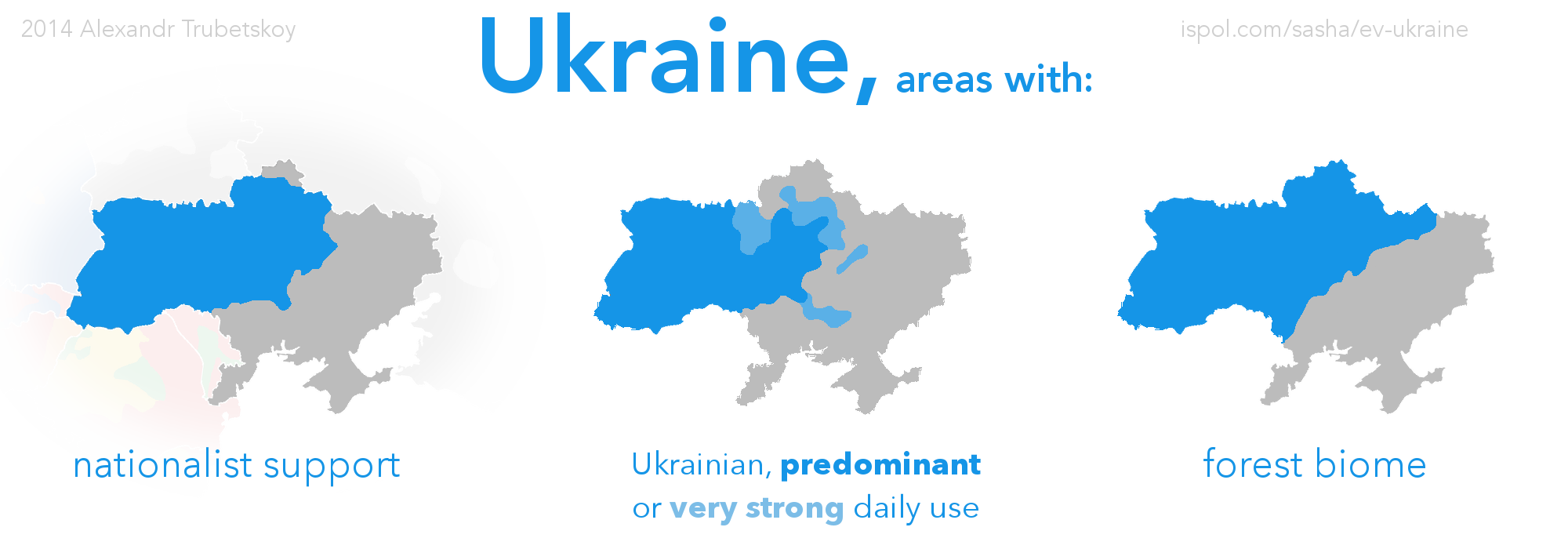Correlations in Ukraine
2 May 2015

The electoral division in Ukraine is very well-publicized, with countless maps all over Western media cropping up, showing the diagonal line that splits the country roughly north-south.
As someone with a relatively close connection to Ukraine, I had always been deeply aware of this divide. But I never really thought about the root causes, beyond the idea of the Polish, Russian and Ottoman imperial boundaries.
As it turns out, the electoral line rather closely follows the line between the forested (blue) and steppe (grey) regions of Ukraine. The forested region has long been home to Slavic peoples, and was the true cradle of Ukrainian culture. The steppe, meanwhile, was historically Tatar-inhabited. And when the Tatars were removed by successive Muscovite and Russian military campaigns, the fertile steppes were suddenly prime, virgin lands for resettlement. Most of this resettlement occurred in the early 1800s, around the same time that the American Heartland was being settled by Europeans. That is why many people make the case that “Novorossiya” is as Russian as Ohio is American—a central point in the debate regarding the Russian Federation’s interests there. However, I will leave political dogma out of this discussion.
So while the forests were always Ukrainian, Polish and Belarusian, the steppes changed hands and by 1850 were settled mostly by Russian-speaking people, who spoke a southern dialect of Russian somewhere between modern standard Russian and modern standard Ukrainian (MSU). Since this dialect can be classified as both “Russian” and “Ukrainian” (as in reality it was both), you will see history books and maps disagreeing on the topic. However, it was not as similar to MSU, which was codified during Soviet times; although MSU is derived from south-Kiev (central) dialects of Ukrainian, the lexicon was infused with West-Ukrainian idiosyncrasies. This means that today, while Ukrainian grammar is similar enough to Russian to be mostly mutually intelligible, individual vocabulary words often come from very different roots.
The end result is that the steppe is populated by people closer (culturally, ethnically, politically) to Russia, while the forest continued its Polish-influenced Ukrainian legacy.
Note on Russian vs. Ukrainian language use:
The spread and use of the Ukrainian language within Ukraine is a highly contentious issue. My map (in the middle) may surprise many Westerners who are used to seeing this map.
The map in the link shows what people consider to be their “mother tongue”. Thus, most Ukrainians, seeing as they identify as Ukrainians and live in Ukraine, will indicate Ukrainian as their “mother tongue”. However, this does not represent the linguistic reality in Ukraine. Very many ethnic Ukrainians actually use Russian more in everyday life. The “everyday life” aspect of language distribution was captured with the help of Vkontakte, Ukraine’s most popular social network, and Twitter.
An analysis of both websites shows a very similar pattern, which I generalized on my map with the help of a Gaussian algorithm.
Thus, my map represents the day-to-day language reality in Ukraine, rather than the language of government, “mother” or “native” tongue, or other misleading indices.
Finally, it should be noted that the linguistic transition from east to west in Ukraine is very gradual, so much so that the difference between adjacent towns/cities is usually not noticeable. The map only represents an accurate approximation of a fluid and blurry boundary.